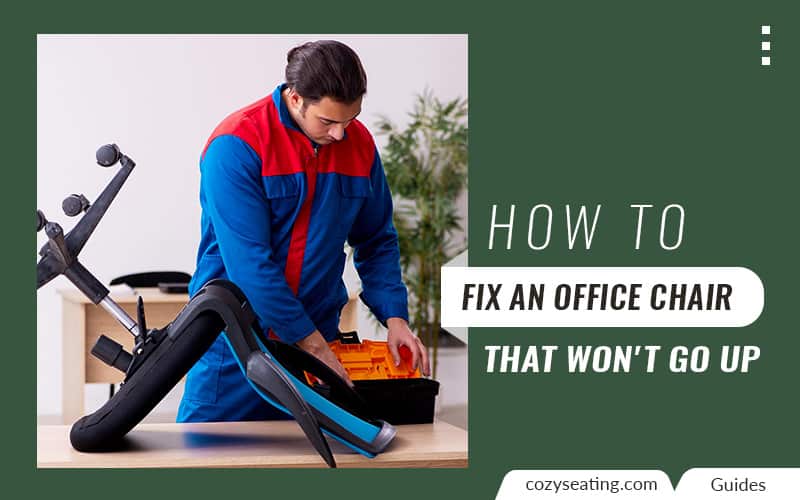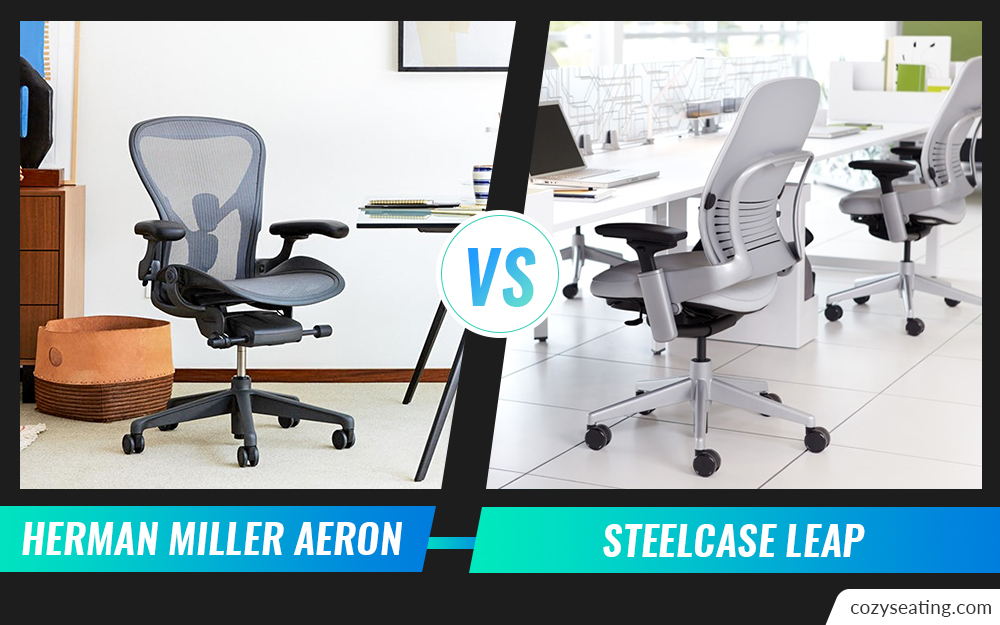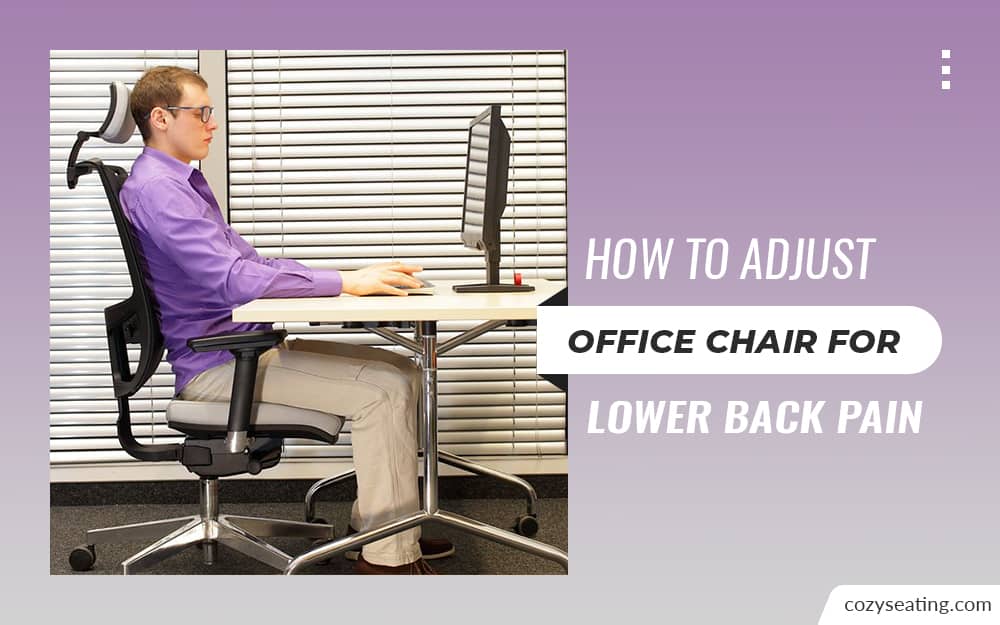
Disclosure: This site is reader-supported & contains affiliate links. We may earn a commission through products purchased using links on this page. Learn more

For some people, your chair may sink each time you sit on it. But what happens when your chair cannot rise at all? And what causes your office chair’s height adjustment to fail?
Below, I discuss how to fix an office chair that won’t go up in easy-to-understand ways.
You fix an office chair that won’t go up or down by replacing a broken cylinder, replacing a broken lever, or realigning a dislodged one. Still, you can make your office chair taller using a platform, larger wheels, cushions, woodblocks, threaded posts, and extension kits.
Table of Contents
How Do You Fix an Office Chair That Won’t Go Up or Down?
The main reason your office chair fails to rise is that your gas cylinder has issues. These may include a leak or the valve is stuck open. If you have any of these problems with your gas cylinders, then it’s time for them to replace it.
You need:
- A screwdriver
- An adjustable wrench
- Some pliers
- Your new gas cylinder
Begin by overturning your office chair so that the casters hang in the air. This should allow you access to your chair’s hind.
Position your wrench on the gas cylinder and turn it counterclockwise until it comes off.
If it seems challenging, lubricate the joint between the cylinder and the metal plate with WD40, let it rest for some time, and pull again.
Detach the cylinder from the base.
Next, take your new cylinder and attach the base to it. Set the base with the cylinder down and lower the rest of your chair onto it.
After this, sit down to ensure everything locks into place.
Adjustment Lever Issues
Secondly, your chair may fail to go up because your height adjustment lever is broken or dislodged. You need a Phillips head screwdriver and an adjustable wrench to fix your chair’s height adjustment lever.
First, undo the three screws that attach the top portion of the chair to the base. Lift the top section away from the base.
Once done, look underneath the chair to see which side of the chair the height adjustment lever is. Using the Phillips head screwdriver, pry the lever upwards until it pops loose.
Slide the lever to the front of the chair. With the lever now facing forward, slide it downwards until it clicks into position. Tighten the previously undone screws.
After that, turn the chair over. Now, sit on the chair and try the height adjustment lever again. Does it work? If yes, great job! If not, follow the following steps.
First, check whether the spring tensioner is working correctly. Unclip the metal clip that secures the spring tensioner to the armrests.
Gently tug on the spring tensioner while pushing against the lever. Make sure the lever moves freely. If it does not, then there might be something wrong with the mechanism itself.
The next step is disassembling the entire chair. Check whether any parts are missing or damaged. If everything looks fine, then consider contacting the manufacturer directly. They’ll probably have more information about what needs fixing.
How Can I Make My Office Chair Taller?
If none of the previous fixes work, consider replacing your chair altogether. Still, you can try out other ways to get your office chair up.
So, what are some other fixes to get your desired chair height without having to correct the chair’s height adjustment mechanism?
Place Your Office Chair on a Platform
When choosing a platform to place your chair upon, make sure that it has enough space beneath it to accommodate the width of your desk.
Also, ensure that the surface area under the platform is large enough to support the weight of your chair.
Place the legs of your chair on the platform first. You want them to be at least 2 inches tall. Next, put the seat cushion on top of the legs.
Finally, add the backrest to complete the seating arrangement. Sit down and enjoy your newly elevated office chair!
Factors to Consider When Deciding the Platform to Place Your Chair on Top Of
1) Is the Platform Sturdy?
Some platforms come from wood, plastic, etc., but they’re usually flimsy. A good quality platform lasts longer than cheaper ones.
2) How Much Room Do You Have Beneath the Platform?
Do you have plenty of clearance to fit your computer monitor, keyboard, mouse, printer, speakers, and the like?
3) What Kind of Material Is the Platform Made Of?
Wood tends to warp after years of sitting. Plastic may crack in time as well. Metal platforms tend to hold their shape better.
4) Are the Feet Attached Securely?
Ensure your feet stay attached. It’s essential for stability purposes.
5) Can You Adjust the Height of the Platform Easily?
This way, you don’t need to worry about getting stuck with an office chair fixed on a single height.
6) Will This Platform Allow You to Use All Four Wheels of Your Chair?
Most chairs come with two rear wheels. However, many people prefer using only one wheel because it makes maneuvering easier.
7) How Easy Is it to Clean?
Cleaning a wooden platform takes extra effort since dirt gets trapped between the planks. But cleaning a plastic platform requires no special tools whatsoever.
8) How Comfortable is the Platform?
Comfort matters, especially if you spend long hours seated behind your desk.
9) How Durable Is the Platform?
Durability refers to how often the platform breaks down. For example, a cheap plastic platform could break within months of being used. On the contrary, a high-quality steel platform should last several years before breaking down.
10) Does the Platform Provide Adequate Ventilation?
Ventilation helps prevent mold from growing inside the platform.
11) How Heavy Is the Platform?
Heavy platforms require more robust materials such as aluminum instead of lighter options like plastic.
Use a Wedge Cushion
A wedge cushion helps raise your chair slightly higher than its original level. It works best if you’re sitting straight up in your chair.
Place the wedge cushion behind the backrest of your chair. Push the wedge cushion firmly against the backrest.
Next, slowly lower yourself back until you feel comfortable. Repeat this severally until you reach the desired elevation.
What should you weigh when buying a wedge cushion for your office chair?
1) How Much Do You Weigh?
This determines how high you should elevate your chair. For example, someone who weighs 150 pounds may need to elevate their chair by only 5″.
On the other hand, someone weighing 300 lbs may require elevating their chair by 10″.
2) Do You Prefer a Soft or Firm Wedge Cushion?
Soft cushions tend to provide better comfort, but they also allow airflow through the cushion. Firm cushions don’t let as much air pass through, so they offer less comfort.
However, they prevent movement from occurring between the cushion and the backrest.
3) What Kinds of Material Do You Like?
Some people find foam wedges uncomfortable because they stick to the skin. Others love the feeling of leather wedges.
There are many different types of materials available today. They include vinyl, polyurethane, and memory foams.
Each type offers unique benefits depending on your personal preference.
4) Is the Wedge Cushion Adjustable?
Most wedge cushions come equipped with two screws which enable you to adjust the angle of the wedge cushion. By adjusting these screws, you can change the amount of pressure applied to the backrest.
5) Does the Wedge Cushion Fit All Chairs?
Not every office chair comes with a wedge cushion. Therefore, before purchasing one, make sure that yours fits.
6) Are There Any Special Instructions Included?
Many manufacturers include specific directions regarding the installation and care of the wedge cushion. If not, check online for additional information about using the wedge cushion.
Other Methods
Office chairs typically come with two to two-and-a-half-inch wheels. Getting casters at three or four inches allows you to slightly raise your chair’s height.
That said, casters are not as flexible as inflatable cushions or platforms when it comes to height flexibility.
Moreover, you can attach a wooden block on each arm of your chair’s base to raise it. You can also turn your threaded post anticlockwise or use extension kits.
Frequently Asked Questions
How Do You Fix Hydraulics in an Office Chair?
You fix the hydraulics in your office chair to allow you to adjust the height with ease by taking it to a professional.
It isn’t the best thing to repair your chair’s hydraulic system yourself if you have no clue what you’re doing. You could damage something irreparable. That is why I recommend having your chair repaired professionally at least once per year.
Why Is My Office Chair Sinking?
Your office chair is sinking because the seat pan has become worn down over time; you have a faulty gas cylinder or some loose screws. Your office chair may also sink because of an improperly adjusted caster or a damaged frame.
Conclusion
Getting your chair to move up and down easily helps improve your posture while sitting. In addition, it helps get rid of soreness after long sitting periods. And some of these fixes, like using cushions, are highly time-efficient.
Recommended Reading

How to Remove Greasy Head Stains from a Leather Chair
Even the most expensive leather chairs are prone to greasy head strains. I’ll guide you on how to remove greasy head stains from a leather chair today. Read on.

Herman Miller Aeron Vs Steelcase Leap
The Herman Miller Aeron Vs Steelcase Leap comparison is mostly about comfort and support. The fact is that Leap supports better than Aeron in many ways.

How to Adjust Office Chair for Lower Back Pain
Persistent back pain becomes a serious issue if ignored. Adjusting your office chair can solve it. Here’s how to adjust office chair for lower back pain.

How to Fix Squeaky Office Chair With Easy Steps
Your office chair is squeaky because some parts are loose, rusted, dirty, lost, or broken. Here’s how to fix squeaky office chair like a pro!
